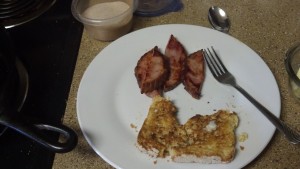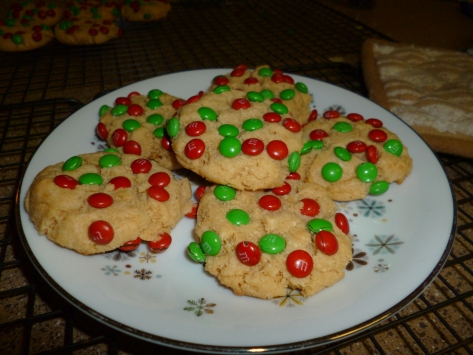So, I try to eat gluten free as much as possible, with the goal of going grain free once I’ve gotten the wheat free thing under control. But as a life-long baker, it’s hard to give up some of the fantastic things I’ve always made, like home made bread. And let’s face it, it can be difficult to figure out what to pack for lunch at work when suddenly a sandwich is no longer the easy option. I ran across a bread recipe in a Facebook-shared article (that I sadly did not note the website when I jotted down the recipe) and decided to try it. It turned out fantastic with a few alterations and substitutions I made on my own. Here’s my version.

A quick breakfast of ham slices and GF toast…soon to have a dusting of cinnamon sugar.
Gluten-free Oat Bread
Makes 1 9-inch loaf
1 c. brown rice flour
1/2 c. GF Oat flour (take 1/2 c. GF oats and process in a food processor for about 1 minute until it resembles flour, you can leave it a little coarse for texture if you like)
3/4 c. AP GF flour mix (original recipe calls for sorghum or millet flour here, but I was unable to find either at my grocery store and didn’t want to go to the specialty store the day I tried this)
1/2 c. tapioca starch/flour (it can be labeled either starch or flour, it’s the same thing)
1/4 c. corn starch (original calls for potato starch, again I couldn’t find this at my grocery store so I used what I had on hand)
1 pkg or 2 1/4 tsp. active dry yeast
1 1/2 tsp salt
(2 tsp xanthan gum is called for in the original recipe. I don’t think it’s really all that necesary, and it’s quite expensive. I skipped it and my loaf turned out fine)
2 eggs + 1 egg yolk
2 Tbsp honey (maple syrup or amber agave nectar could also be used here)
1/4 c. shortening, melted
1 1/4 c. milk, warmed to 110 to 120 F (any type of milk works, nut milks, soy, dairy, etc)
for tops of loaves:
1 egg white, lightly beaten (a couple of drops of water can also be added)
1/4 c. (apx) GF oats
Prepare a 9 inch bread ban by greasing well and dusting with some additional brown rice flour. Set aside.
Mix dry ingredients just to combine.
Whisk together wet ingredients.
Add wet to dry and mix until well combined. Mix for 5 minutes on medium-high speed. It will be a very thick batter, like cake batter.
Spoon batter into prepared pan. Be careful that the batter doesn’t go past half filling the pan, if it does, the batter will spill over during rising. If you have excess batter, you can prepare a few muffin tins as you did the loaf pan and make a few rolls.
Using a pastry brush, lightly brush the top of the dough with the egg white. Sprinkle GF oats on top.
Let dough rise in a warm place 40 minutes or until nearly double in size. Pre-heat oven to 350 F. (This dough will actually double in size! Loosely cover with plastic wrap before draping a kitchen towel over the pan unless you want a doughy kitchen towel!)
Bake apx. 40 minutes, internal temp should be 200 F. I actually used a clean meat thermometer to double check my loaf. It was golden brown looking, but that can sometimes be deceiving. Rolls may take about 10 minutes less.
Cool in the pan for 10 minutes before turning out onto cooling racks. Be gentle when taking out of the pan.
I baked mine in a clear glass loaf pan so that I could check browning on the bottom as well. I was perhaps a bit overzealous with the greasing and flouring of my pan, but my loaf didn’t stick at all. I found that the slices were a little prone to breaking into large chunks when I attempted to make a sandwich for work. Slicing was a fairly delicate task. But the bread it’s self tastes wonderful, and lacks the flat, grainy texture of so many wheat free concoctions. The loaf didn’t dry out when left in a ziploc bag on my counter all week without refrigeration. And it made pretty respectable toast this morning a week after baking. My slice did break into two pieces coming out of the toaster, but I think that was a function of my particular loaf.
I’m definitely going to try this again and use some different flours and starches. I’m curious how it will work with an exclusively non-grain line up of flours and starches. I’ll be picking up some coconut flour, almond flour and more tapioca starch tomorrow to try this out with a “paleo” bent. (Tapioca starch is made from a tuber grown in South America and fits into the general guidelines of the Paleo diet. My concern is avoidance of grains, for which this starch fits the bill.)

